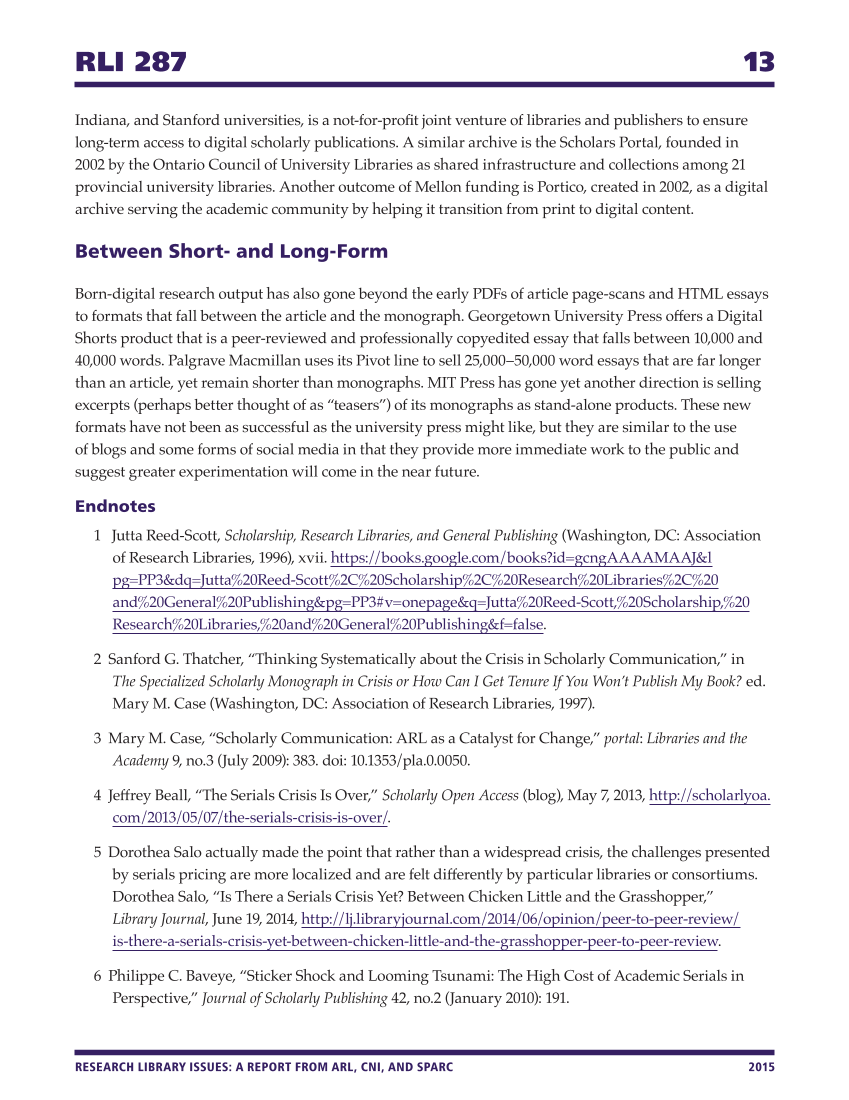RLI 287 13 RESEARCH LIBRARY ISSUES: A REPORT FROM ARL, CNI, AND SPARC 2015 Indiana, and Stanford universities, is a not-for-profit joint venture of libraries and publishers to ensure long-term access to digital scholarly publications. A similar archive is the Scholars Portal, founded in 2002 by the Ontario Council of University Libraries as shared infrastructure and collections among 21 provincial university libraries. Another outcome of Mellon funding is Portico, created in 2002, as a digital archive serving the academic community by helping it transition from print to digital content. Between Short- and Long-Form Born-digital research output has also gone beyond the early PDFs of article page-scans and HTML essays to formats that fall between the article and the monograph. Georgetown University Press offers a Digital Shorts product that is a peer-reviewed and professionally copyedited essay that falls between 10,000 and 40,000 words. Palgrave Macmillan uses its Pivot line to sell 25,000–50,000 word essays that are far longer than an article, yet remain shorter than monographs. MIT Press has gone yet another direction is selling excerpts (perhaps better thought of as “teasers”) of its monographs as stand-alone products. These new formats have not been as successful as the university press might like, but they are similar to the use of blogs and some forms of social media in that they provide more immediate work to the public and suggest greater experimentation will come in the near future. Endnotes 1 Jutta Reed-Scott, Scholarship, Research Libraries, and General Publishing (Washington, DC: Association of Research Libraries, 1996), xvii. https://books.google.com/books?id=gcngAAAAMAAJ&l pg=PP3&dq=Jutta%20Reed-Scott%2C%20Scholarship%2C%20Research%20Libraries%2C%20 and%20General%20Publishing&pg=PP3#v=onepage&q=Jutta%20Reed-Scott,%20Scholarship,%20 Research%20Libraries,%20and%20General%20Publishing&f=false. 2 Sanford G. Thatcher, “Thinking Systematically about the Crisis in Scholarly Communication,” in The Specialized Scholarly Monograph in Crisis or How Can I Get Tenure If You Won’t Publish My Book? ed. Mary M. Case (Washington, DC: Association of Research Libraries, 1997). 3 Mary M. Case, “Scholarly Communication: ARL as a Catalyst for Change,” portal: Libraries and the Academy 9, no.3 (July 2009): 383. doi: 10.1353/pla.0.0050. 4 Jeffrey Beall, “The Serials Crisis Is Over,” Scholarly Open Access (blog), May 7, 2013, http://scholarlyoa. com/2013/05/07/the-serials-crisis-is-over/. 5 Dorothea Salo actually made the point that rather than a widespread crisis, the challenges presented by serials pricing are more localized and are felt differently by particular libraries or consortiums. Dorothea Salo, “Is There a Serials Crisis Yet? Between Chicken Little and the Grasshopper,” Library Journal, June 19, 2014, http://lj.libraryjournal.com/2014/06/opinion/peer-to-peer-review/ is-there-a-serials-crisis-yet-between-chicken-little-and-the-grasshopper-peer-to-peer-review. 6 Philippe C. Baveye, “Sticker Shock and Looming Tsunami: The High Cost of Academic Serials in Perspective,” Journal of Scholarly Publishing 42, no.2 (January 2010): 191.


























